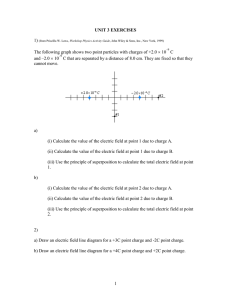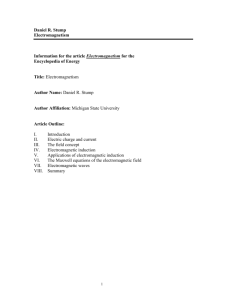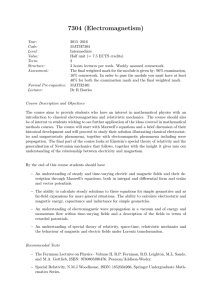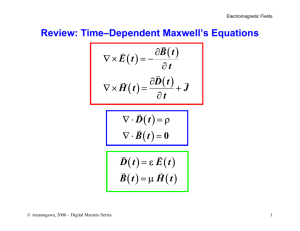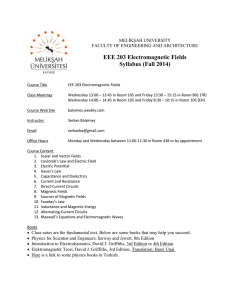The theory of electromagnetic field motion 3. The relativistic principle
advertisement
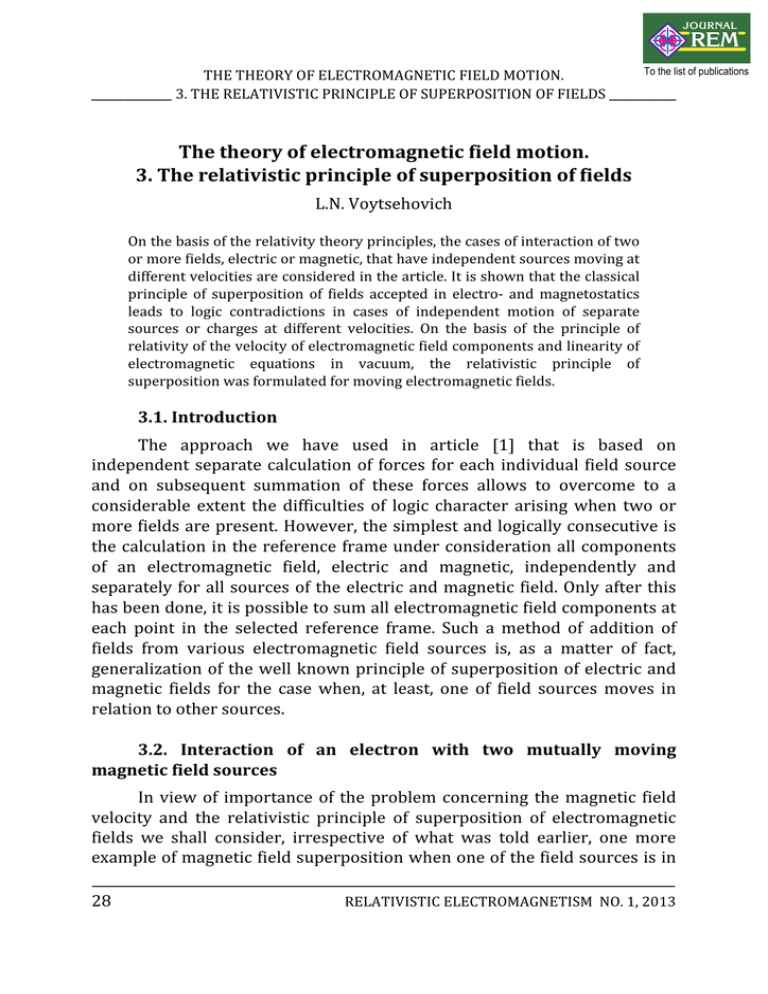
JOURNAL REM To the list of publications THE THEORY OF ELECTROMAGNETIC FIELD MOTION. ____________ 3. THE RELATIVISTIC PRINCIPLE OF SUPERPOSITION OF FIELDS __________ Thetheoryofelectromagneticfieldmotion. 3.Therelativisticprincipleofsuperpositionoffields L.N. Voytsehovich On the basis of the relativity theory principles, the cases of interaction of two or more fields, electric or magnetic, that have independent sources moving at different velocities are considered in the article. It is shown that the classical principle of superposition of fields accepted in electro- and magnetostatics leads to logic contradictions in cases of independent motion of separate sources or charges at different velocities. On the basis of the principle of relativity of the velocity of electromagnetic field components and linearity of electromagnetic equations in vacuum, the relativistic principle of superposition was formulated for moving electromagnetic fields. 3.1.Introduction The approach we have used in article [1] that is based on independent separate calculation of forces for each individual field source and on subsequent summation of these forces allows to overcome to a considerable extent the difficulties of logic character arising when two or more fields are present. However, the simplest and logically consecutive is the calculation in the reference frame under consideration all components of an electromagnetic field, electric and magnetic, independently and separately for all sources of the electric and magnetic field. Only after this has been done, it is possible to sum all electromagnetic field components at each point in the selected reference frame. Such a method of addition of fields from various electromagnetic field sources is, as a matter of fact, generalization of the well known principle of superposition of electric and magnetic fields for the case when, at least, one of field sources moves in relation to other sources. 3.2. Interaction of an electron with two mutually moving magneticfieldsources In view of importance of the problem concerning the magnetic field velocity and the relativistic principle of superposition of electromagnetic fields we shall consider, irrespective of what was told earlier, one more example of magnetic field superposition when one of the field sources is in 28 RELATIVISTIC ELECTROMAGNETISM NO. 1, 2013 THE THEORY OF ELECTROMAGNETIC FIELD MOTION. ____________ 3. THE RELATIVISTIC PRINCIPLE OF SUPERPOSITION OF FIELDS __________ motion. At the same time we shall answer the remark in the citation we made in article [1], from the monograph by I.E.Tamm's [2], about what is obtained when fields of two magnets interact with each other if one of them moves. So, the question of a rotating field we shall discuss in one of our papers to be published later. Instead of permanent magnets let`s make use of current carrying circular turns (fig. 3.1) because current in a turn may be switched off at any moment, without removing a turn, which is easier and more evident compared to removal of a permanent magnet itself. All designations in fig. 3.1 relating to a motionless turn and turn A itself are represented in the dark blue color, a turn with the current disconnected is bice. Accordingly, moving turn B and designations on it are green, and turn with disconnected current has the pale green color. A negative probe charge e, an electron, which is in the centre of the system of rings at the moment of time under consideration, and also the force F acting on it, are of the red color. As long as we are interested in qualitative conclusions, we shall consider for simplification that electron velocity v (left column on fig. 3.1), which is equal to the velocity of turn B, is much less than the velocity of light c, that is the condition v <<c is satisfied. Otherwise it is necessary to use relativistic transformations for high velocities for quantitative estimations, which does not influence the generality of qualitative conclusions. We shall consider magnetic fields B1 and B2, induced by currents I1 and I2 accordingly to be homogeneous and equal by their absolute values in the central area, at the point where the electron e is located. Let's consider the cases when one or two of the three values, two currents I1, I2 and electron velocity v, are equal to zero. The total number of six combinations is possible, which is illustrated in fig. 3.1. The case when currents I1 and I2 are equal to zero is excluded from consideration in view of a triviality. The cases in figures 3.1a and 3.1b are classical: in laboratory reference frame S1 with a motionless turn A with current I1, the source of magnetic field B1, an electron e moves at velocity v (fig. 3.1a) or it is at rest (fig. 3.1b). Current I2 in turn B (reference frame S2) is equal to zero. The cases in figures 3.1c and 3.1d differ from the previous ones by the fact that current I2 is switched on. The cases in figures 3.1e and 3.1f, in turn, differ from the cases shown in figures 3.1c and 3.1d by the fact that current I1 in turn B is switched off. RELATIVISTIC ELECTROMAGNETISM NO. 1, 2013 29 THE THEORY OF ELECTROMAGNETIC FIELD MOTION. ____________ 3. THE RELATIVISTIC PRINCIPLE OF SUPERPOSITION OF FIELDS __________ Fig. 3.1. Interaction of electromagnetic fields from two sources: Motionless (dark blue color) and moving source with a velocity v (green color). Negative probe charge e, an electron, and force acting on it are represented in red. Two approaches are possible to estimate force F acting on a probe charge (an electron), and electric field E1 and E2 in reference systems S1 and S2. 3.3.Thequasiclassicalapproach The first approach, actually classical, is based on consideration of mental experiment and using of known conclusions of the classical theory. The cases shown in fig. 3.1a, b, c and d, are the cases with single field source widely presented in the literature. 30 RELATIVISTIC ELECTROMAGNETISM NO. 1, 2013 THE THEORY OF ELECTROMAGNETIC FIELD MOTION. ____________ 3. THE RELATIVISTIC PRINCIPLE OF SUPERPOSITION OF FIELDS __________ In fig. 3.1a force F is the Lorentz force. In reference frame S2 the same force is caused by electric field E2. On fig. 3.1b force F is equal to zero.In reference frame S2 two forces compensating one another act on electron: the electric force by field E2 and the Lorentz force from magnetic field B2 (the forces are not shown in the figures). It is strange enough to explain the absence of any forces by presence of two mutually compensating forces but very often it gets so. The same can be repeated for the situation in fig. 3.1e if the observer is not in reference frame S1 but in system S2. The situation in fig. 3.1f is similar to the situation in fig. 3.1a if the observer in system S1 will change its position to reference frame S2. Situation in fig. 3.1c and fig. 3.1d is more difficult because magnetic fields B1 and B2 cancel one another. It follows from problem symmetry and equality of the magnetic fields by their absolute values. To clear the situation we shall serially disconnect current in turns A and B. Disconnecting current in turn B, we shall come to the case in fig. 3.1a, disconnecting current in turn A, we shall come to the case in fig. 3.1e. We shall summarize all effects represented in fig. 3.1a and 3.1e. We have the right to summarize, since all the equations of electromagnetism are linear in vacuum and, hence, all the effects that arose when fields impose on one another should be summarized. As a result of summation we come to the situation represented in fig. 3.1c: the total field B is equal to zero, force F is equal to the same force as in fig. 3.1a, but now it is caused not by a magnetic component of the Lorentz force but by an electric one. And what does this component represent itself? Naturally, electric fields E1 and E2, are not summarized, because they relate to different reference systems, but each remains invariable in fig. 3.1c in summation in its own reference frame. It would seem possible to apply the expression to the full Lorentz force, which contains not only a magnetic component of the force that is usually meant as the Lorentz force but also an electric component: F = q (E + [vB]), (3.1) where q is an electric charge. Here, for the case in fig. 3.1c B = 0, and E1 does not influence the net force (see fig. 3.1e). If it is considered that E = E2, we shall receive a correct RELATIVISTIC ELECTROMAGNETISM NO. 1, 2013 31 THE THEORY OF ELECTROMAGNETIC FIELD MOTION. ____________ 3. THE RELATIVISTIC PRINCIPLE OF SUPERPOSITION OF FIELDS __________ result. However, such an approach is very similar to the "fitting" of the problem solution to the answer, since in the case in fig. 3.1a we attributed force F in laboratory reference frame to the Lorentz force and ignored field E2, and in a similar situation in fig. 3.1e, where the Lorentz force is absent, we have to explain the force by presence of electric field E2. The logic contradiction in interpretation of the results obtained from our mental experiment is obvious. A similar situation is observed in fig. 3.1d. The logic contradiction mentioned above can be bypassed, if the electric field is defined for each case in the intrinsic frame of reference of the electron where it is at rest, and if the concept of the Lorentz magnetic force is abandoned. It is possible to be convinced after having looked at fig. 3.1 that in the intrinsic frame of reference of the charge the magnetic component of the force is equal to zero in every case, and the total force acting on the electron is entirely determined by the electric field. This field E2 is in the left column in fig. 3.1 and the field E1 is in the right column. The forces acting on the charge may be recalculated, when necessary, for any other reference frame using the relevant formulas of relativistic mechanics. In such an approach to estimate the force there is no necessity to consider fictitious mutually compensated forces, calculation of the force becomes more clear and consecutive. In interpretation of the physical nature of the force applied to the electron through a magnetic field, it is possible to speak about the Lorentz force without logic contradictions only when the charge moves in a motionless magnetic field in fig. 3.1a, which case, however, is the most important in practice. Application of the Lorentz force concept in this case is justified by existing traditions and practice, but it is necessary to keep in mind that behind the Lorentz force there is an electric force in the intrinsic frame of reference related to charge. 3.4.Theprincipleofsuperposition The second approach, which is a field one, is based on the principle of superposition applied to electromagnetic field components. In the first approach considered above, we were compelled to appeal to the conditions of mental experiment including the description of field sources, but not to electromagnetic field parameters. In the field approach it is necessary to determine all field characteristics at first, proceeding from experimental conditions, and then calculate a total field abstracting from the 32 RELATIVISTIC ELECTROMAGNETISM NO. 1, 2013 THE THEORY OF ELECTROMAGNETIC FIELD MOTION. ____________ 3. THE RELATIVISTIC PRINCIPLE OF SUPERPOSITION OF FIELDS __________ experimental conditions and using the general principles of superposition for the fields. However, by using classical superposition principle when the electromagnetic field is only characterized by vectors of electric and magnetic components, we shall not obtain a correct result, as in the first approach. Really, let`s exclude from consideration turns A and B with currents I1 and I2 in figures 3.1a and 3.1b, but let`s take into account presence of fields B1 and B2. We shall also consider that presence of a stationary or moving charge does not influence the result of superposition of fields B1 and B2. In this case we obtain that all components of the total field are equal to zero at electron positions in the mentioned figures, since magnetic fields cancel one another, the Lorentz force in motion of an electron in a zero magnetic field is absent, and an electric field is absent too in any reference frame. This contradicts to the result obtained earlier. Inaccuracy is that we have defined only part of the magnetic field state characteristics. The situation cardinally changes, if the velocity of the components of electromagnetic field is introduced in the number of values that characterize the electromagnetic field. If conditions of the superposition of the field are put in the form of a physical problem, the velocities of each field source component in a laboratory reference frame must be found first, prior to the beginning of superposition process and independently on conditions of other field sources. Then complementary components for each of a field source are calculated using Lorentz transformations formulas for the electromagnetic field, if field values are set in an intrinsic reference frame in accordance with the problem specification. If the values of fields in laboratory reference frame are known, it is necessary to use expressions (2.3) or (2.5) that we obtained in previous article [1]: B 12 [Ve E], c (3.2) where c is the velocity of light, and E [Vm B] , (3.3) applying (3.2) or (3.3) depending on a field source, electric or magnetic. RELATIVISTIC ELECTROMAGNETISM NO. 1, 2013 33 THE THEORY OF ELECTROMAGNETIC FIELD MOTION. ____________ 3. THE RELATIVISTIC PRINCIPLE OF SUPERPOSITION OF FIELDS __________ Then, all components of the same name from each field source are summarized and, in conclusion, if necessary, an intrinsic velocity of the resultant field is calculated using formulas (2.8) or (2.9) [1], depending on the sign of invariant I1 (2.6). 3.5.Applicationoftheprincipleofsuperpositiontosolvetheproblems ofelectromagnetism As an example of application of the presented above principle of superposition for electromagnetic fields we schematically show the method of calculation of a magnetic field around an infinite (very long) current carrying wire. The current circuit is supposed to be motionless. The electric current is known to be represented as opposing motion of positive and negative electric charges in a wire (in metals velocity of positive charges is equal to zero if the conductor is stationary,). Thus, it is necessary to consider two sources of the electric field, moving at various velocities which are equal to averaged velocities for positive V+ and negativeV- charges respectively. Electric fields of both sources E+ and E-, respectively move together with charges in the opposite sides. Motion of the electric fields results in occurrence of magnetic fields B+ and B− caused by moving positive and negative charges respectively: B 12 [VE ] , c B 12 [VE ]. c (3.4) Vector equations determine the magnitude and direction of resultant field B components. Directions of both components B+ and B− in (3.4) coincide, as it is easy to be convinced. Let`s summarize field B and convert vector equation (3.4) into the scalar form, which does not cause difficulties, as long as vectors V, E and B are orthogonal for both positive and negative charges: B B B 12 (V E V E ) . c 3.5) For a linear infinite charge, the electric field strength at distance r from the charge is defined, as it is known, by the following expression: 34 RELATIVISTIC ELECTROMAGNETISM NO. 1, 2013 THE THEORY OF ELECTROMAGNETIC FIELD MOTION. ____________ 3. THE RELATIVISTIC PRINCIPLE OF SUPERPOSITION OF FIELDS __________ E , 20r E , 2 0r (3.6) where τ+ and τ- are linear densities of positive and negative charges, respectively. The net linear current I is equal to the sum of currents of positive I+ and negative I- charges: I I I V V . (3.7) Consistent substitution of (3.6) and (3.7) in (3.5) gives rise to the known formula for the magnetic field of an infinite current carrying conductor: B I . 2 0c 2r (3.8) The resultant electric field will be equal to zero because the conductor is neutral and the current carrying circuit is motionless. Magnetic field generation by electric current and its occurrence in other cases can be explained similarly on a single basis. One may be convinced without much trouble that in each case the same formulas will be derived, as those obtained on the basis of Maxwell’s equations. It doesn't matter what is kept in mind: a current in a wire, an electron beam or movement of a single elementary particle bearing an electric charge. However, it is necessary to warn against possible errors when a solution is found to the electromagnetic problems associated with curvilinear movement of charges. This problems concerns, for example, the motion of charges along a circular turn, or motion of bound charges at rotation of solids. In all the cases, the charge and field connected to it are in translation motion at a velocity which is equal during each moment of time to the instant velocity of a co-moving intrinsic inertial reference frame of the charge that corresponds to the infinitesimal current element. In an instant comoving reference frame of an elementary charge the velocity of the electric RELATIVISTIC ELECTROMAGNETISM NO. 1, 2013 35 THE THEORY OF ELECTROMAGNETIC FIELD MOTION. ____________ 3. THE RELATIVISTIC PRINCIPLE OF SUPERPOSITION OF FIELDS __________ field is the same and also is equal at every point of space to the instant velocity of an intrinsic reference frame. The intrinsic field of charges of current element doesnotrotate. The same relates also to the magnetic field. As shown further, the magnetic field rotary motion, for example, can lead to electric charge generation. The similar situation about charge occurrence in a rotating solenoid is described in article [3] that is absolutely inadmissible because leads to infringement of the charge conservation law. Conclusions 1. Any electromagnetic field containing independent from each other electric and magnetic components should be considered as a superposition of fields. 2. Every independent field component has the velocity coinciding with a source velocity which may be stationary or move at some velocity relative to other sources. If all field sources except one are removed, there should be only one, electric or magnetic, component of the electromagnetic field in an intrinsic reference frame of the remained source in which it is stationary. 3. In a laboratory reference frame each of the independent components related to the source can move at some velocity relative to the laboratory reference frame irrespective of other components. 4. As a result of motion of each independent component in the laboratory reference frame complementary electric or magnetic component appears relative to moving one, depending on the considered problem. The electric and magnetic field of each source in the laboratory reference frame is subordinate to Lorentz transformations for the electromagnetic field irrespective of the fields created by other sources. 5. For the laboratory reference frame the following principle of superposition is valid. All components of the electromagnetic field, electric and magnetic, are calculated in the laboratory reference frame independently and separately for every source of the electric and a magnetic field. Then, all components of the electromagnetic field with the same name are summarized for each point of the laboratory reference frame. Such a method of addition of fields from various electromagnetic field sources is generalization of the known principle of superposition for 36 RELATIVISTIC ELECTROMAGNETISM NO. 1, 2013 THE THEORY OF ELECTROMAGNETIC FIELD MOTION. ____________ 3. THE RELATIVISTIC PRINCIPLE OF SUPERPOSITION OF FIELDS __________ electric and magnetic fields for the case when one or more of field sources move relative to other sources. 6. Irrespective of the motion character of a composite field source (rotation in particular) the fields of elementary sources (charges of a solid body, charges of current elements, elementary magnetic moments of a magnetized body and other elementary field sources) always perform translational motion. This fact should be taken into account in summation (superposition) of elementary fields according to the principle of superposition stated above. References 1. L.N. Voytsehovich, Theory of motion of electromagnetic field. 2. Principle of motion of electromagnetic field components, 1, (2013), P. 12. www.science.by/electromagnetism/rem2eng.pdf. 2. I.E. Tamm, Fundamentals of electricity (И.Е. Тамм, Основы теории электричества), Moscow, Nauka, (1966), PP. 549 – 553. 3. E.A. Meerovich, B.E. Meyerovich, Methods of relativistic electrodynamics in electrical engineering and electrophysics (Э.А. Меерович, Б.Э. Мейерович, Методы релятивистской электродинамики в электротехнике и электрофизике), Moscow, Energoatomizdat, (1987), PP. 84 – 86. JOURNAL REM ArticleispublishedonthesiteofREMjournal OnMarch,31st,2013 To the list of publications RELATIVISTIC ELECTROMAGNETISM NO. 1, 2013 37

